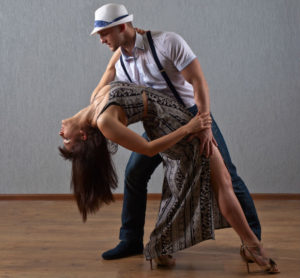Brazilian regional music has Los Angeles and the world dancing.
Brazil is a country rich in rhythms and dances. While samba and bossa nova have conquered fans around the world for some time now, many of the country’s regional rhythms and dances have made it out into the wide world too.
One of these regional styles of music is forró from the Nordeste – Northeastern Brazil. Actually, it’s a genre of music that encompasses various styles, including different ways of dancing to it.
In Los Angeles, two champions of forró are Andrea Lopaso and Fábio Santana, both originally from the state of São Paulo. Not only do they teach forró on a weekly basis, they also organize a dance party with live music and general merriment every month.
Andrea has been dancing since she was 3 years old. Fábio also remembers dancing with his family since he was an infant. They met in Los Angeles in 2009 and danced socially. They began teaching in 2013 and have since created forró central in Los Angeles.
Trying to pin them down as to exactly what forró is and the style of dance they teach is as illusive to define as is the music itself. They note that like many styles of music and dance, it’s hard to pin down origins and definitive descriptions.
Forró became popular outside of the Nordeste when people from the region migrated to other parts of Brazil fleeing poverty and persistent droughts. Artists, such as Luiz Gonzaga, brought their music with them and eventually gained a following not only among nordestinhos longing for memories of home, but others drawn to the music. From there things took off.
When it comes to dance, in general, there are three different rhythms of dance: xote, baião and arrasta-pé. And each of those encompasses different styles. For example, under xote there are forró love, muidinho, merenguinho, cavalguinho, etc. For baião there are pé-da-serra, cacao, forró fieira, etc. What make them distinct from one another are often tempo (paired with a particular style of forró music), body positioning (are you plastered against your partner’s body or more separate) and/or action (are there lots of turns involved or not).
As Andrea and Fábio point out, styles get mixed and are transformed by the dancers wherever they gather.
Like Cuban rueda de casino, there are regional differences, even international differences. In fact, Fábio admits he’s been influenced by rueda de casino and is creating his own version of it for forró. In class he’ll gather partners in a circle and before you know it there’s a bunch of switching partners going on.
Back to style . . . both suggest that the most familiar style might be universitário. This is a style that came out of the big cities of southern Brazil (read São Paulo and Rio de Janeiro) and consists of lots of turns. In general, if you dance salsa, you will see similarities.
Andrea and Fábio are pleased that forró has gained wide popularity as Brazilians moved around the world and took their love of forró with them.
“In Europe, it’s huge,” says Andrea. She notes that in the United States, Boston is recognized for having a particularly big following.
To check out some forró recording artists, Fábio recommends—in addition to Luiz Gonzaga—Jackson do Pandeiro, Marinês and Dominguinhos. And if you are ever in Los Angeles, join Fábio and Andrea at one of their weekly dance classes held at the Brasil Brasil Cultural Center located at 12453 Washington Blvd. Visit https://forroinla.com for more info.


Leave A Reply